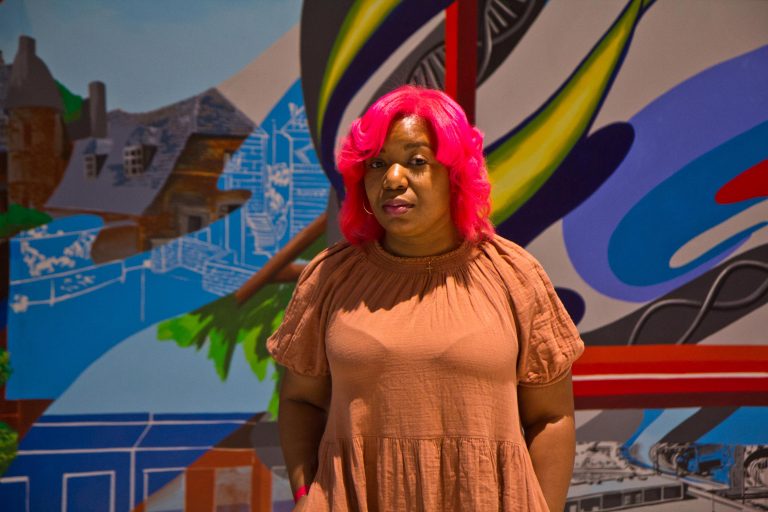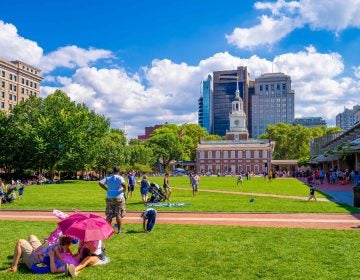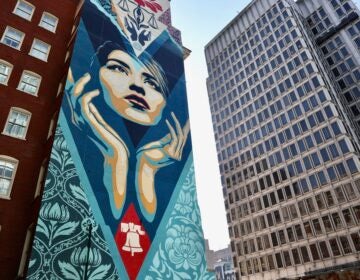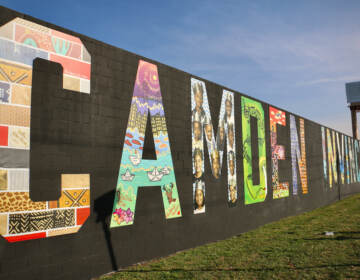A West Philly artist is the latest designer to bring the old Bulletin Building into the future
Artist Serena Saunders manifested her commission to create a mural for the 3025 Market St. icon on social media.

Artist Serena Saunders with her mural "The Path" at the Bulletin Building across from 30th Street Station in Philadelphia. (Kimberly Paynter/WHYY)
A positive painting experience. An Instagram post. A company willing to invest in local artists.
Serena Saunders has always had a passion for art, but only recently discovered the joy of murals. After months of research and painting, she can now count herself among an elite cast of artists and designers who have left an imprint on the Bulletin Building, an icon in the West Philadelphia community where Saunders grew up and still resides.
The high-profile commission marked her first stint as a lead muralist — an opportunity she manifested just days before on social media.
“I was painting in Center City near Broad Street, and while painting and engaging with the community at the same time on a much smaller project, something in my heart just got excited, and I was like ‘this is something that I want to do,’” Saunders said. She posted about the vision and within 24 hours, she got the call from an art consultant. Spark Therapeutics had recently signed a 12-year lease at the 3025 Market St. landmark recently renovated by Philadelphia architect Kieran Timberlake. The company wanted a large mural to welcome visitors to the new headquarters, one of 10 buildings included in Brandywine Realty Trust’s 14-acre Schuylkill Yards master plan.
“I felt like a prayer had been answered,” Saunders said.

The 32-by-13.8-feet mural now hangs prominently inside the lobby of the glass and red brick landmark just west of 30th Street Station.
The painting features a hue of vibrant reds, yellows, and greens and depicts the history of Philadelphia as well as Spark’s role in helping the community build a future. Aptly titled “The Path,” the mural encompasses four major elements: the legacy of architect George Howe, who designed the Bulletin Building and influenced the design of Philadelphia’s rowhouses; the history of the Bulletin Building itself and the persistence of the city’s newspaper it housed; the influence of Spark Therapeutics; and finally, community. The building looks out to Drexel Square, a 1.3-acre green space developed by Brandywine in hopes of helping the nascent business district become a place for people to connect.
“We start and we end with the community,” Saunders said. “The community is our anchor, which I think is important because Spark comes from the community, the artists, all of us come from the community, and the goal is to contribute to the community.”
For the muralist, the Philadelphia-based gene therapy startup’s patient-centered mission of transforming genes into medicines struck a chord. She made sure to weave her own personal experience into the mural in the hopes that it would in turn reflect other members of the Philadelphia community.
“A lot of [the mural] comes from what I felt was my DNA attached to the larger story of Spark, George Howe, the Bulletin Building, and the community,” she said. “Even the personal aspects that were specific to me, like my son attends Drexel and my father suffered from illnesses, [which helped me] relate to the work that Spark does, I feel the larger community also can relate to those things.”
Spark Therapeutics partnered with visual arts organization InLiquid to find an artist who could create a piece that represents the company’s mission. It was InLiquid founder and artistic director Rachel Zimmerman who called Saunders after her manifest-making social media post.
Saunders spent four months working on the mural, collaborating with Zimmerman.
“In the first three minutes of talking to Serena, she got it,” said the InLiquid founder. “She knew what we were talking about, she really understood in a very profound way and did the homework and the research to really do something more than just a mural, but to really speak to the program, to what Spark is about, to what the building is about, to what the community is about, so that it really is a living piece of a mural. It talks about the history, but it really talks about the future as well.”
The pandemic complicated the mural’s creation, making it harder to source materials due to the disrupted supply chain. Saunders said she couldn’t paint on site, and saw her work completely assembled for the first time at the public unveiling.
InLiquid guided her through those challenges, Saunders said. Outside support like that provided by InLiquid is important for emerging artists to balance perfecting their craft with sustaining themselves financially, she added.
“Artists, in general, have had to put on the business hat, the accountant hat, the marketing hat, all these different tools to be able to break the cycle of what a starving artist would be and instead become a business person, an entity that can represent themselves to the bigger world as an artist,” she said.
Since her childhood, Saunders has always seen art as a form of activism and historical documentation — a perspective she brings to all of her work.
“Being a brown girl, I’ve always wanted to see more art that reflected people who look like me and live like me, and so I’ve always made a conscious effort to document what I see and what I experience and the people I’ve met and the people I know to make sure that hundreds of years from now, when art is still standing beyond us, there’s an accurate depiction of who we are right now and the beauty and the struggle,” she said.
Disclosure: Spark Therapeutics CEO Jeffrey D. Marrazzo is the son of WHYY’s president and chief executive officer William Marrazzo.

Subscribe to PlanPhilly
WHYY is your source for fact-based, in-depth journalism and information. As a nonprofit organization, we rely on financial support from readers like you. Please give today.








